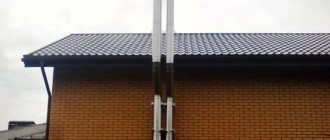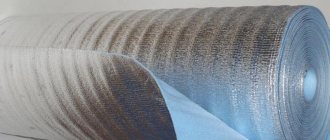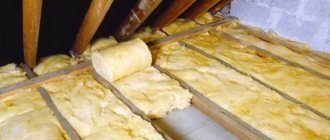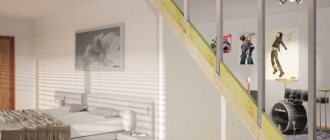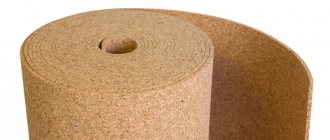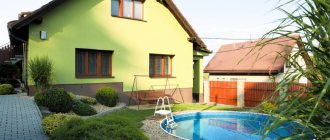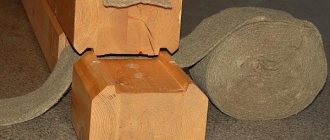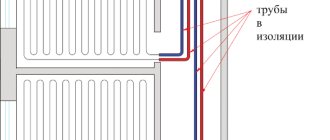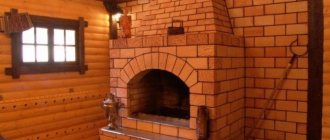External insulation
This method is used in private houses with an attic. Compared to internal insulation, this type of insulation is simpler to implement and takes much less time and effort. So:
- The entire area of the attic is covered with an overlapping layer of vapor barrier material (glassine) 5-10 cm wide, the joints are taped with adhesive tape or tape.
- The sheathing is made from boards with a section of 30-40 x 100-200 mm (the width, as with internal insulation, depends on the thickness of the mineral wool layer).
The distance between adjacent beams is calculated according to the width of the roll or insulation boards. We make lathing (grooves) for laying mineral wool - When insulating the ceiling externally, it is recommended to lay a layer of foam plastic 5 cm thick on top of the vapor barrier layer. Thanks to it, the level of vapor barrier increases significantly.
Lay a layer of foam plastic - Mineral wool is laid on the foam plastic in a layer of 10-20 cm. It is important that when laying, there are no gaps left between the insulation layers and the sheathing beams.
The process of laying mineral wool in grooves on the roof - If the mineral wool is covered with foil on one side, then the flooring is made so that this part is on top. In this case, an additional layer of waterproofing is not needed. If the mineral wool is ordinary, then it is carefully covered with an overlapping layer of waterproofing material on top, the joints are glued with adhesive tape or tape and everything is secured with counter-battens.
- Next, a floor made of wooden boards, chipboard or OSB is installed.
Proper insulation of walls from the inside of a private house with your own hands in several ways
To build a comfortable, warm home, it is not enough just to install heating and seal the seams .
With thin walls that do not retain heat well, heating costs will be incredibly high, and the heat in the house will not be retained. To ensure that warm air does not escape from the room, and that the walls perform not only the function of protection from external influences, but also the function of thermal insulation, it is necessary to insulate them.
The following materials are suitable for insulation:
Internal insulation
The need for internal ceiling insulation is most typical for houses with several floors or with an attic, as well as for city apartments. The entire scope of work consists of the following stages:
- Ceiling lathing - can be made of boards with a section of 30-40 x 100-200 mm (the width of the board directly depends on the thickness of the insulation layer) or a metal profile. The lathing is attached to the ceiling using nails or self-tapping screws, and the distance between adjacent parts should be about 50-60 cm, depending on the width of the mineral wool used.
- A layer of waterproofing is attached to the finished sheathing - strips 50-60 cm wide are cut out plus a tolerance of 5 cm on each side, i.e. the final width will be 60-70 cm. These strips are attached with counterbattens to the wooden sheathing or with self-tapping screws to the profile.
- Next, mineral wool is laid and fixed with glue or a construction stapler to the ceiling, or, if the layer is thick, to the sheathing.
Fastening mineral wool to the ceiling - The next layer is a vapor barrier using glassine. It is mounted on mineral wool using a stapler.
- The finished structure is secured by transverse fixation of counter rails or profiles.
We attach mineral wool to the ceiling - The internal insulation procedure is completed, the next step is installation of plasterboard, panels or stretch ceilings on the sheathing.
Requirements for thermal insulation thickness
Before deciding on the parameters of the material, you need to take into account a number of characteristics that affect them. The thickness of the thermal insulation depends on the climate conditions, what the building and walls are made of.
The following parameters will be required for the calculation:
- heat transfer resistance coefficient in the region;
- thermal conductivity of building and finishing materials, thickness of each;
- characteristics of the insulation itself.
The heat transfer resistance coefficient is established by building codes.
Data by region are indicated in SNiP. Table of some coefficients
| City | Resistance, m2 degrees/W |
| Moscow | 3.28 |
| Krasnodar | 2.44 |
| Rostov | 2.75 |
| Sochi | 1.79 |
| Saint Petersburg | 3.23 |
| Voronezh | 3.12 |
| Kazan | 3.45 |
You can find out the thermal conductivity coefficient of materials and the insulating membrane from the technical documentation attached to the product.
If you do not perform complex calculations for many situations, the optimal thickness of insulation for a standard frame structure is 150 mm . It meets the climate conditions of central Russia.
For severe winters, the insulation layer will have to be increased by installing thermal insulation and an additional frame.
The total wall thickness is brought to 200-250 mm. The thicker the walls, the thinner the insulation layer should be.
In terms of thermal insulation characteristics, 50 mm mineral wool is comparable to 50 cm timber.
To build a house for permanent residence, instead of 450 mm timber, profiled 150 and 100 mm are used; after shrinkage, the walls are insulated with material 50-100 mm thick.
The standard thickness of walls and insulation is provided for by SNiP 02/23/2003:
- In houses for living only in the warm season, the wall thickness is 150-200 mm without additional insulation. Resistance coefficient – 1.26 m2 degrees/W.
- To stay in a cottage in winter and summer, the heat transfer resistance should be about 3.06 m2 degrees/W. If you try to achieve this only due to the thickness of the timber, the walls can be about 50 cm.
But, if you use insulation and timber with a small cross-section, the design will be optimal. In practice, with a wall of 150-170 mm, 100 mm of mineral wool is sufficient for the heat transfer resistance to reach 3.1 m2 degrees/W.
External wall counter-lattice
Outside the house, with the help of counter-lattice, a gap is created to ventilate the facade, which is why such facades are called ventilated.
Usually the counter-lattice is placed along the slab cladding of the wall, but if there is no slab cladding, then it is nailed to the frame posts themselves, and a windproof film is placed between them.
The pitch of the counter-lattice is usually 400 mm, and its typical cross-section: 40x50 or 50x50mm. If the façade cladding is carried out vertically, then after the counter-lattice the lathing is installed.
Material for making a frame for siding
Basically, to create the lathing, stainless steel is used, which is produced as PP ceiling profiles 60x27x3000 mm or wood treated with antipyrines, as a more budget option.
For lathing, use a metal profile or wooden beams.
We will look at how to make sheathing for siding from each material. First of all, installing sheathing under siding requires the following materials:
- wooden beams or stainless steel metal profiles treated with a special agent as the main material for the sheathing for siding;
- insulation, for which foam boards or rolled mineral wool are often chosen;
- about four metal hangers per three meters of frame for attaching beams or profiles;
Tip: instead of hangers, sometimes they use pieces of timber attached with dowels or self-tapping screws to the outer walls.
- self-tapping screws with large threads, 0.35 cm in diameter, up to 0.4 cm long for attaching hangers to wooden walls and 0.35 cm in diameter, up to 0.35 cm in length for attaching hangers to the sheathing;
- self-tapping screws with a sharp tip, diameter 0.42 cm, length up to 0.16 cm in the case of using profiles;
We invite you to familiarize yourself with an extension to a wooden house with your own hands
Ready solution
If you do not know exactly how to properly make a sheathing for siding, what technical characteristics of the fastening system are necessary for a particular type of siding, choose a ready-made solution from a panel manufacturer.
So, I developed a special plastic sheathing that is suitable directly for branded siding. Moreover, different types of panels have their own profiles. For example, for the Alta-Siding and Canada Plus collections, a D 4.5 profile was made, for Block House siding - VN-01 and VN-02.
The company also provided two options for installing siding - with insulation (then 138 mm studs are used) or without it (53 mm studs).
Installation of such a ready-made system does not require special skills or equipment. The algorithm of actions is simple:
Select and order the necessary elements from the company’s assortment.
Set the horizon around the perimeter of the house and make markings.
Secure the bottom heel of the profile horizontally.
Align the profile vertically using a level and secure the top heel.
Secure the middle heel.
Sequentially install the remaining profiles in increments of 30-40 cm.
For corners and openings, use a flat profile with a metal corner element.
Check the accuracy of installation vertically and horizontally and finally align the profiles using a hexagon. After this, you can install the siding.
Metal profile for siding -
This is the most popular type of lathing for plastic finishing and this is understandable:
- the metal does not need to be pre-prepared and processed,
- it makes it easier to insulate the house if necessary,
- it's quite easy to work with,
- In terms of installation speed, it is not inferior to wood.
Metal profiles for siding can be found in every market today. The only requirement for this type of frame is that the thickness of the profile for the siding must be impressive. It is advisable to take one-and-a-half or, for example, millimeter ones. Of course, many people use thinner metal to save money, but I don’t recommend it.
After all, we are talking about a facade, and it is often subjected to colossal loads. And thin metal corrodes much faster. Insulating a house using metal sheathing is really as easy as shelling pears, especially if it is soft insulation: to do this, you need to install hangers on the facade, push cotton wool through them (they will hold it), and then safely attach the profile to the hangers on both sides. That's all science is.
Some useful points when insulating
For thermal insulation to be effective, not only the insulation, but also the roof must be installed correctly. In addition, it is worth remembering some rules of insulation:
- If there is a need to insulate the roof and make excellent sound insulation, then cotton insulation is best suited, as they perfectly absorb extraneous noise. Expanded polystyrene, on the other hand, is not capable of providing a decent level of sound insulation, but it also does not require laying additional soundproofing material unless it is necessary to create absolute silence.
- Proper installation of insulation is half the battle. If moisture leaks through any membrane or roofing material, the effectiveness of the insulating layer is reduced to almost zero. When about 2 percent of moisture from its own weight accumulates in the insulation, it leads to a loss of about half of its effectiveness. Therefore, the correct installation of vapor barrier and waterproofing membranes, as well as the installation of the roof covering, is important.
- When purchasing, transporting and storing thermal insulation material, you need to ensure that the packaging always remains intact. At the slightest damage, the insulation begins to absorb moisture, which is then very difficult to get rid of. Installation should only be done in sunny and warm weather.
- When choosing insulation, you should not focus on such a concept as hydrophobicity. Indeed, some cotton insulation can repel moisture, which cannot be said about the air that is between the fibers. When purchasing, you should focus on such a concept as water absorption - the lower the coefficient, the better.
An important criterion is fire safety. And this applies not only to rafters and sheathing, but also to insulation. As already noted, all polystyrene foams are flammable materials. There are four flammability groups in total.
The most fireproof insulation will be that which belongs to the first group G1.
However, it is worth noting that all four groups burn well, the only difference is that the fourth group can independently support the combustion process. Materials belonging to the first group stop burning immediately after the fire source is removed, that is, such materials are not capable of independently supporting the combustion process.
Advantages and disadvantages of slab insulation
Board thermal insulation materials are the most popular due to their ease of installation and excellent thermal insulation properties.
Slab insulation based on polyurethane foam or polystyrene foam
retains heat best. Resistant to rotting. Has excellent waterproofing characteristics.
However, it has one drawback - it has practically no noise-absorbing properties. In addition, all foams burn, releasing toxic substances into the air.
Mineral wool based insulation
It is considered one of the best for external walls due to its excellent vapor permeability characteristics. Basalt wool is also practically indeformable throughout its entire service life and does not corrode.
Mineral wool has high sound insulation properties and belongs to the class of non-combustible materials. Moreover, it is used for fire protection. That is why mineral wool is most often used as insulation in wooden houses made of timber, frame houses and buildings with wooden finishing (imitation timber, lining, block house, etc.).
Lathing
Lathing is used for ventilated facades. This is due to the fact that soft insulation, in principle, is not used for “wet” facades. It does not have sufficient rigidity to support the required weight of the plaster layer.
If you plan to finish in the form of “Bark Beetle” or “Lamb”, proceed to the following methods. Lathing is often used for thermal insulation from the inside. There she fully justifies herself.
So, how is the sheathing done?
- Necessarily! A vapor barrier film secured with staples must be laid on the wall;
- The lower base profile is screwed on;
- On top of the vapor barrier, using self-tapping screws, a beam with a thickness equal to the thickness of the insulation is screwed. The width of the beam should be actually equal to the width of the slab, but be 2-5 centimeters smaller. The most commonly used beam pitch is 60 cm.
- After this, starting from the bottom into the sheathing, the mineral wool is laid.
The slabs in the sheathing should fit tightly. In this case, the cold will not pass through the gap between the timber and the slab. But this approach is not used very often. It is applicable primarily to wooden houses.
Also, soft mineral wool slabs necessarily require not only a vapor barrier on the inside, but a windproof layer on the outside. Otherwise the wind will blow.
Installing wind protection is an additional expense, so two other mounting methods are often used.
Laying the slabs in the sheathing is the right way when the question arises: how to attach the insulation to the ceiling.
For dowels
In 90% of cases, mineral wool and other materials are attached to the wall using dowels.
What a dowel is and what they are like is described separately.
Now we will simply describe the sequence of work when using this method.
First of all, if adhesive was initially used to fix the insulating boards, they must be well secured. Most often, fastening with dowels can be carried out 2-24 hours after gluing. A more accurate figure can be found in the instructions for the adhesive composition.
- Select and purchase an umbrella of the required length;
- We drill a hole into which the fastening element will be driven;
- Insert the dowel into the hole;
- Using a hammer, hammer in the anchor (with plastic nails you need to be especially careful when applying force).
Our sheet is securely fixed.
Floor lathing
In the case of a floor, the lathing rather serves as an additional floor joist or counter joist. It is used to additionally insulate floor joists at the top or bottom. For example, 150 mm logs 100 mm lathing or 200 mm logs 50 mm timber.
Also, using floor lathing, you can make the ceiling more “monolithic”. For example, logs are 200x50 with a pitch of 600, and on them logs are 100x50 with a pitch of 400 mm. Such an overlap will be many times stronger. The typical pitch of such lathing is 300-400 mm.
We invite you to familiarize yourself with Finnish houses: technology for building popular and comfortable housing
Typical lathing cross-section: 50×50, 100×50, 150×50.
Plastic lathing for siding
Let me start by bragging. Among siding installers, only a few undertake the installation of siding on plastic sheathing, because this requires certain knowledge and special qualifications.
This is not easy technologically and takes a little more time, but our teams can easily install the plastic subsystem for siding.
We are not looking for easy money, so if you really want it, we will be happy to “frame” your home with a polymer fastening system, because it has several excellent advantages.
- The sheathing profiles, like the siding, are made of plastic, which means that they will expand and contract in response to sudden temperature changes. The consequence is that the panel will not work in the event of a sudden cold snap.
- The panels will also not “work” due to the fact that an inexperienced installer will not tighten the panels or screw the self-tapping screw “to death”, and this is one of the most common mistakes of siding installers. They will not be able to do this due to the fact that the profile structure has a special shape that protects you from installation errors.
- The profile geometry repeats the geometry of the siding panel, becoming like a stiffening rib for it, and this indicates that the facade will become even more reliable.
Among the disadvantages of polymer sheathing, I would like to note that installation is actually a little longer and the price is comparable to the cost of metal sheathing, and sometimes even a little higher. It is possible to insulate the facade if you use a plastic siding fastening system - you will need to use ordinary metal hangers. We install insulation on them, and then screw the profiles on the sides through special side linings (I’ll tell you about this in detail someday).
Adviсe
In conclusion, a few words should be said about small tricks that will help avoid numerous problems after insulating the ceiling with mineral wool:
- The small fibers that make up mineral wool cause itching and irritation when they come into contact with exposed skin and respiratory tracts. To avoid harm to health, it is necessary to use special clothing and a respirator.
- When using metal profile lathing, it may later turn out that cold air continues to flow through the ceiling in the corners. To eliminate the occurrence of such a problem, after fixing the metal profile to the ceiling, all corners are carefully filled with polyurethane foam.
- Due to errors in calculations, the thickness of the mineral wool layer may exceed the width of the lathing. In this case, additional bars are nailed onto the wooden beams. If the sheathing is made of a metal profile, you will have to replace the hangers or reduce the insulation layer.
- When laying mineral wool, compacting and pressing it is strictly prohibited - this leads to a decrease in the number of air bubbles inside the insulation and, as a result, loss of thermal insulation properties.
- In places where spotlights are installed, it is necessary to provide space for air circulation in order to avoid subsequent problems with their constant burnout.
- The most suitable screws for fixing a metal profile are self-tapping screws made of hardened steel.
- You can determine the current state of the insulated ceiling using a device such as a thermal imager. When turned on, the screen indicates in red the places where cold air passes through.
- All of the above is designed to minimize and optimize the financial and physical costs of insulating the ceiling with mineral wool. However, to get the best results, you should seek advice from specialists. They will help you make correct calculations of the required thickness of the insulation layer and, based on this, calculate the total amount of material and its cost. Often such companies directly cooperate with manufacturers of insulation materials, which can result in additional savings on purchases.
What you need to know
When insulating wooden walls, it is necessary to note several important factors that ultimately affect the result of construction work:
- Reducing area . Exceptions may occur when installing a log house with a log diameter of 40 cm or more; here only the inter-crown space is closed.
- Increase in humidity . This happens when using any material, and improper thermal insulation can cause a decrease in the service life of the room. The thermal insulation properties of the insulation itself also decrease, it becomes wet, and wooden surfaces become moldy and rot.
To prevent this, be sure to use a vapor-permeable film and install a powerful ventilation system. There must be an integrated approach to insulating a room; everything will have to be insulated. If there is an unheated attic or basement, they are given no less importance in order to prevent general heat loss.
In terms of efficiency, external insulation is much better than internal insulation. The walls from the inside do not accumulate heat, so heat loss can be up to 15%.
The main heat losses (up to 40%) occur on doors and windows. Therefore, tightly fitted double-glazed windows and door panels are used here, and slopes are insulated. One of the installation mistakes is maintaining gaps between walls, floors, partitions or ceilings. These “cold bridges” conduct heat outward, causing the room to become cold.
Types of profiles for sheathing
Construction of a frame for siding cladding.
The construction of sheathing for siding is carried out from two types of materials - wooden bars or metal profiles. Most often, the CD-60 profile and beams with a section of 50x50 mm are used for lathing.
If it is necessary to create a larger gap between the wall and the siding, wider bars (50x75 and 50x100 mm) can be used. If the wall needs insulation, then 2 layers of sheathing are attached to it.
We suggest you read: How to arrange a play area for a child in an apartment
The lathing can be combined (both bars and metal profiles are used to create it).
There are practically no restrictions on the use of metal profiles for siding panels, but wood laths for the frame can be used with greater caution.
For example, it is completely unsuitable for installation in the basement of a building, where the humidity level is much higher. Before installing the frame, the bars must be sufficiently dried, since lathing made from damp wood is unlikely to retain its original shape.
Its warping can lead to deformation of the finishing coating of the facade.
The optimal humidity of the beams should be 10-15%, so it is better to install wooden sheathing in the summer and in dry weather, and before installation, allow the beams to dry additionally, but not in the sun, but under a canopy, ensuring free air exchange for the wood.
https://www.youtube.com/watch?v=gFNjiepmaRo
When buying wood for sheathing, choose the smoothest bars, and before installing the frame, treat the wood with antiseptics and remove wane from its surface, which can become a home for pests.
The second stage - preparation of the bar
The finished material must be prepared accordingly.
The work instructions look like this:
- STEP 1: the material should be placed for a couple of days in the room that will be finished. This will allow the bar to acclimatize so that its temperature and humidity are the same as in the room.
- STEP 2: the elements are treated with an antiseptic composition. This can be done using a regular brush, treating all surfaces in order. You can do it differently and make a trough from the boards, which is covered with film. An antiseptic is poured there, and the block is simply dipped; this option provides the highest quality protection.
If there is a lot of bar, then it is easier to make a trough so that you can quickly process it by dipping
- STEP 3: While the products are drying, you can prepare the walls. To do this, markings along the width of the racks are applied to the surface. The work is done using a pencil and a level so that the lines are straight. This will allow you to clearly see what the structure will look like and will simplify your work; you will not need to be distracted by monitoring the correct position of the elements;
When marking vertically, you can use a plumb line rather than a level
- STEP 4: Measurements are taken to determine the length of the bars. It is better to do this in several places, since the walls or ceiling may be uneven;
Do not forget to leave gaps of 5-10 mm so that the block does not rest and deform due to changes in temperature and humidity.
- STEP 5: cutting the block is done with a hacksaw or jigsaw. Here it is important to correctly mark the elements and cut them perpendicularly so that the ends are even. It is also advisable to treat the cut off areas with an antiseptic so that the bar is completely protected from moisture and pests.
Siding sheathing price
This is perhaps one of the most difficult parts of my article. Prices for sheathing for siding vary so much that it is almost impossible to derive an arithmetic average, so I will simply list some of my thoughts about the price of the frame.
- Installation of the siding subsystem from cheaper to more expensive looks like this: wooden sheathing, metal sheathing, plastic sheathing.
- Wooden lathing, despite its cheapness, has a number of disadvantages: it must be dried and treated with who knows what before installing it on the facade, so immediately discard this option.
- Metal profiles are the most common option for arranging a frame for siding installation, but metal is susceptible to corrosion, so be sure to choose profiles made of thick metal. I was “rummaging” on the Internet and found this thing: Such profiles cannot be used for installing siding! They are thin - therefore, they will rot quickly, and they may not be able to withstand the load of the facade in the event of gusty winds. Conclusion: if you use metal profiles, then take thick ones - at least 0.6 mm! Don't save money.
- Plastic sheathing. According to the manufacturers, the product is good. I have made several facades using this fastening system. The feelings are twofold: on the one hand, it’s really easy to install siding on this sheathing. Everything happens quickly and the installer will not make mistakes, but! The installation of profiles itself is quite nerve-wracking. One metal profile is a three-meter stick, but a plastic one is a one-meter stick. Accordingly, there is three times more fuss. The level should always be at hand. And if Asad suggests insulation, then this is generally a long story. It takes some getting used to. Our brigades are already used to it, the vast majority of others are not.
- Do not forget that the cost of the sheathing also includes fasteners. We don’t save on self-tapping screws - we only buy galvanized ones!
- If you plan to insulate your house, don’t forget about the hangers! Often installation crews do not include them in the price, but when they arrive at the site and receive the first part of the cost of the work, they suddenly remember about them)
- The last point is traditional. Comrades, don’t skimp on the façade! If you are embarrassed by the too high price, write to me, I will give you advice and explain: you are being deceived or the cost is adequate (even if you are not using our services). If the price is low, also be on your guard.
Concluding my speech, I will give several links to a video of installing sheathing on a house for installation of siding about this important part of the ventilated facade, and of course, as usual, I will recommend our teams to you. They will do everything right. I guarantee you this.
